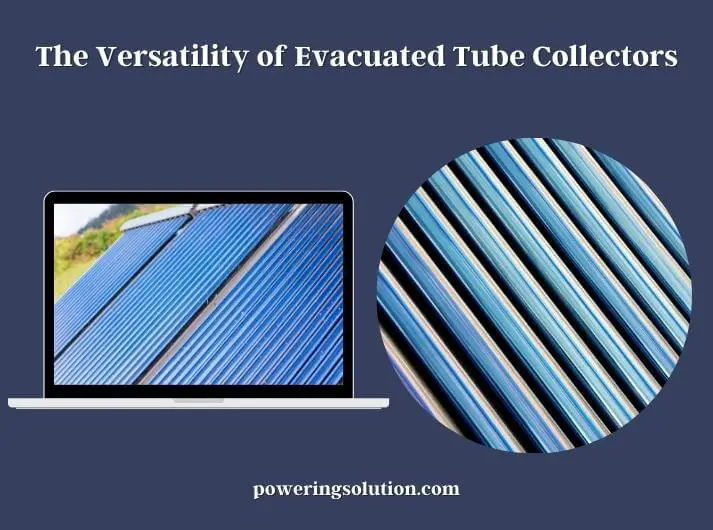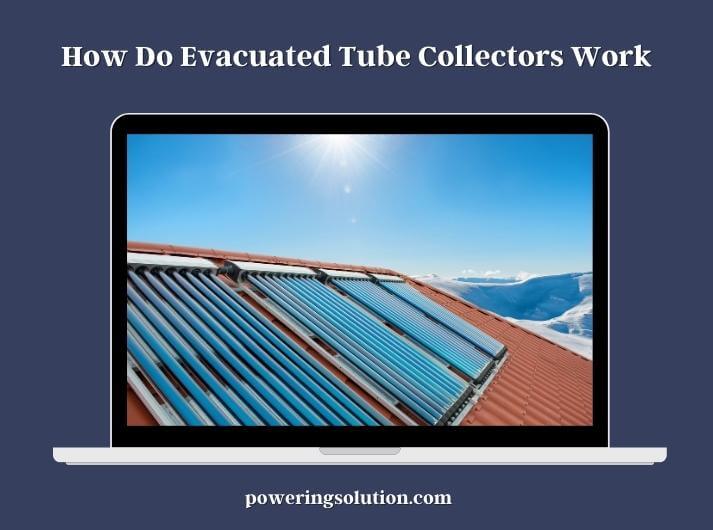As the world becomes increasingly concerned with sustainable energy solutions, there has been a growing interest in the use of solar energy. One of the most popular solar technologies is the evacuated tube collector. These devices are highly efficient, versatile, and easy to install, making them a great option for anyone looking to reduce their carbon footprint and lower their energy bills.

In this article, we will explore the versatility of evacuated tube collectors, their benefits, how they work, and the different types available in the market.
What Are Evacuated Tube Collectors?
Evacuated tube collectors are solar thermal systems that absorb sunlight and convert it into thermal energy, which can be used for space heating, water heating, and other applications. The system consists of a series of vacuum-sealed glass tubes, which contain an absorber plate that absorbs solar radiation and converts it into heat.
The heat is then transferred to a fluid (typically water or a mixture of water and glycol) that flows through the tubes and into a storage tank or heat exchanger.
How Do Evacuated Tube Collectors Work?
The vacuum-sealed glass tubes used in evacuated tube collectors are designed to minimize heat loss, making them highly efficient even in cold or cloudy weather conditions. When sunlight enters the tubes, it is absorbed by the absorber plate, which is typically coated with a high-absorption coating that maximizes solar energy absorption.

The heat is then transferred to the fluid inside the tubes, which flows through the tubes and into a storage tank or heat exchanger, where it can be used for various applications.
Benefits of Evacuated Tube Collectors
Evacuated tube collectors offer several benefits, including:
- Evacuated tube collectors are highly efficient, even in cold or cloudy weather conditions.
- They can be used for space heating, water heating, and other applications, making them a versatile option for residential, commercial, and industrial use.
- Evacuated tube collectors are designed to last for many years and require minimal maintenance.
- While the initial installation cost may be high, the long-term savings on energy bills make it a cost-effective option in the long run.
- Evacuated tube collectors produce clean and renewable energy, reducing the carbon footprint of a building or facility.
The Versatility of Evacuated Tube Collectors
Evacuated tube collectors are versatile and can be used in various applications, including:
Residential use
Evacuated tube collectors are an excellent option for homeowners who want to reduce their energy bills and carbon footprint. They can be used for space heating, water heating, and pool heating, making them a versatile option for residential use.
Commercial use
Commercial buildings, such as offices, schools, and hospitals, can also benefit from the use of evacuated tube collectors. They can be used for space heating, water heating, and process heating, reducing the energy bills and carbon footprint of the building.
Industrial use
Evacuated tube collectors can also be used in industrial settings, such as manufacturing facilities, where they can be used for process heating and steam generation. They can help reduce the energy bills and carbon footprint of the facility.
Agricultural use
Agricultural facilities, such as greenhouses and farms, can also benefit from the use of evacuated tube collectors. They can be used for space heating, water heating, and other agricultural applications, reducing the energy bills and carbon footprint of the facility.
Remote locations
Evacuated tube collectors can also be used in remote locations where there is no access to grid electricity. They can be used for space heating, water heating, and other applications, providing clean and renewable energy to remote communities.
Types of Evacuated Tube Collectors
Evacuated tube collectors come in two main types: heat pipe collectors and direct flow collectors. Both types consist of a series of vacuum-sealed glass tubes, but they differ in the way they transfer heat from the absorber plate to the fluid in the collector manifold. It’s important to know that flat plate collector are used to harness solar radiation and convert it into thermal energy, which can be used for various applications, such as heating water and space in residential and commercial buildings.
Heat pipe collectors
Heat pipe collectors are the most common type of evacuated tube collectors. They consist of a series of vacuum-sealed glass tubes, each containing a heat pipe that transfers heat from the absorber plate to the fluid in the collector manifold.
A heat pipe is a copper pipe that contains a small amount of fluid, such as alcohol or water, which boils at a low temperature. When sunlight strikes the absorber plate, it heats up the fluid in the heat pipe, causing it to vaporize and rise to the top of the tube. The vapor then condenses on the inner surface of the glass tube, releasing its heat to the fluid in the collector manifold. The fluid then circulates through the system to transfer the heat to the storage tank or heat exchanger.
Heat pipe collectors are highly efficient and can be used in a wide range of applications. They are suitable for high-temperature applications, such as space heating or industrial process heating, and can operate in a wide range of weather conditions, from hot and sunny to cold and cloudy.
Direct flow collectors
Direct flow collectors are less common than heat pipe collectors but offer some advantages in certain applications. They consist of a series of vacuum-sealed glass tubes, each containing a flow tube that carries the fluid directly through the collector. The absorber plate is located inside the flow tube, and the fluid is heated as it passes through the tube.
Direct flow collectors are simpler in design than heat pipe collectors and are less prone to leaks. They are also more suitable for low-temperature applications, such as water heating, and are typically less expensive than heat pipe collectors. However, they are not as efficient as heat pipe collectors and may not be suitable for high-temperature applications.
Installation and Maintenance
Proper installation and maintenance of evacuated tube collectors are essential for the optimal performance and longevity of the system. Here are some key factors to consider when installing and maintaining an evacuated tube collector system:
Installation
Site selection
The site selection is critical to ensure that the system operates at maximum efficiency. The ideal location for an evacuated tube collector system is a south-facing roof or wall with no shading, obstructions, or nearby buildings that may cast shadows on the collector during peak sun hours.
Mounting
The mounting of the collector should be performed by a professional installer who will ensure that the system is securely fastened to the roof or wall and can withstand wind and weather conditions. The mounting angle should be optimized for the latitude of the installation site to maximize solar gain.
Plumbing and electrical connections
The plumbing and electrical connections should be performed by a licensed contractor to ensure that the system is installed safely and meets all local building codes and regulations. The plumbing connections should be checked for leaks, and the electrical connections should be checked for proper grounding and voltage.
Maintenance
Cleaning
The glass tubes of the collector should be cleaned regularly to remove dust, dirt, and debris that may reduce the system’s efficiency. The cleaning frequency will depend on the local weather conditions and the amount of dust and debris in the area.
Inspection
The collector should be inspected regularly for signs of damage, leaks, or other issues that may affect the system’s performance. Any damage or leaks should be repaired immediately to prevent further damage to the system.
Glycol maintenance
If the collector uses a glycol-based heat transfer fluid, the glycol should be checked and replaced periodically to ensure that it maintains its properties and does not freeze or degrade.
Professional servicing
Regular professional servicing of the system is recommended to ensure that it operates at maximum efficiency and to identify and address any issues before they become major problems.
Last Point
Evacuated tube collectors offer a versatile and effective solution for harnessing solar energy and converting it into usable heat for a wide range of applications. They are particularly effective in colder climates and can be used in a variety of settings, from residential homes to commercial buildings and industrial facilities.
With their efficient and reliable performance, evacuated tube collectors are a cost-effective way to reduce energy consumption and carbon emissions while taking advantage of a free and abundant renewable energy source.
It’s important to remember that proper installation and maintenance are crucial for optimal performance and longevity. To get the most out of an evacuated tube collector system, it’s recommended to work with licensed professionals for installation and to perform regular cleaning, inspection, and servicing. With proper installation and maintenance, these systems can provide reliable and efficient performance for many years to come.
